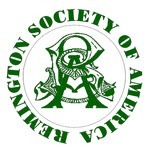Remington Model 241 Autoloading Rifles

by
John Gyde and Roy Marcot
|
The sale of Remington firearms declined dramatically during
the depression. By 1932, losses for the one hundred and
sixteen year old company were approaching $1,000,000 per year. Remington
Arms Company, Inc., headed by Chairman of the Board Marcellus Hartley Dodge, had
little cash for day-to-day operations and practically nothing for product updates or
improvements. Dodge searched for a financial partner, and the call was answered by
the munitions and chemical giant, DuPont. This was a natural because of Remington’s
use of sizeable amounts of DuPont gunpowder. On May 24, 1933, DuPont purchased a
controlling interest in Remington, and with a much needed influx of cash, product
updates at Remington followed almost immediately.
In January 1935, Crawford C. Loomis began design work to improve the
Model 24 autoloading rifle. The result of this work was the new Remington Model 241
rifle and the first production guns were shipped in August 1935, only seven months
later. The Model 241 was a big brother to the Model 24 (similar to the Model 121’s
replacement of the Model 12 slide-action .22 rifle). In fact, Remington’s earliest
advertising stated this to be “a man-sized gun” which was “bigger – heavier – and
better” than the Model 24 it replaced. Since this was a “product improvement” to the
Model 24 autoloader, royalties continued to be paid to John M. Browning’s company.
The barrel on the new Model 121 was longer than its predecessor, the stock
and forend were larger, and some internal parts were strengthened to accommodate the
newer high-velocity ammunition. The interrupted thread concept was continued, but
the Model 241 system was significantly different. It had three raised thread areas as
opposed to two on the Model 24. The take-down button was moved from the bottom
of the receiver to the left side. According to Remington ads, the take-down system was
similar to that in the Remington Model 37 shotgun. It was also very similar to the
Charles Barnes designed system used on the Model 16.
|
|
In Remington’s announcement letter
dated June 21, 1935, the following grades and
retail prices were listed:
Model 241 SA or Model 241 LA
Standard Grade $29.95
Model 241 SC or Model 241 LC
Special Grade $45.30
Model 241 SD or Model 241 LD
Peerless Grade $80.00
Model 241 SE or Model 241 LE
Expert Grade $116.80
Model 241 SF or Model 241 LF
Premier Grade $142.00
|
The letter immediately following the number indicates the cartridge for which the rifle is chambered. “S” stands for Short and “L” for Long Rifle. |
The B Grade was not included in
the original list of offerings. It was introduced
in early 1940.
|
|
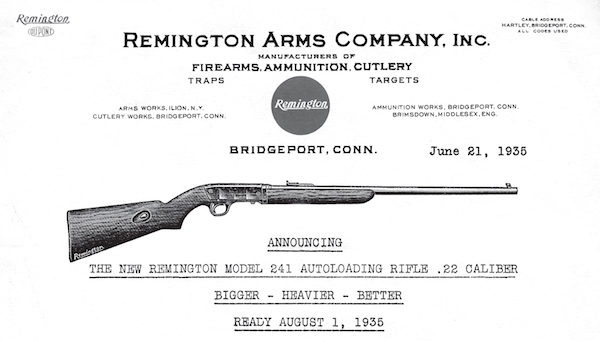
|
Total Sales of Remington Model 241 Rifles
|
| year |
annual sales |
approx. ending serial number |
| 1935 |
7,132 |
7,132 |
| 1936 |
13,203 |
20,335 |
| 1937 |
13,748 |
34,083 |
| 1938 |
7,300 |
41,383 |
| 1939 |
6,204 |
46,587 |
| 1940 |
6,351 |
53,938 |
| 1941 |
2,186 |
56,124 |
| 1942 |
3,895 |
60,019 |
| 1943 |
2 |
60,021 |
| 1944 |
25 |
60,046 |
| 1945 |
3,736 |
63,782 |
| 1946 |
4,992 |
68,774 |
| 1947 |
11,419 |
80,283 |
| 1948 |
13,766 |
94,019 |
| 1949 |
10,154 |
104,773 |
| 1950 |
242 |
105,015 |
| 1951 |
2,330 |
107,345 |
|
|
|
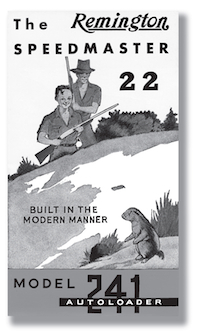
|
These dates and numbers are from Remington Archives records. However, the dates and serial
numbers appear to become increasingly inaccurate after 1946, with serial numbered guns showing
production codes several years later than indicated in the factory records. For example, serial number
121000 was manufactured in March 1949 according to the barrel code. Serial numbers over 132000 have
been observed. To add to the confusion, duplicate serial numbers were issued on 200 Model 241s (serial
number 60669 to 60869 in October 1941). The serial numbering system cycled back to 60669 after 60869
was stamped. Serial numbers were not required at that time and there was concern that polishing and restamping
might weaken the receiver, so the receivers were used.
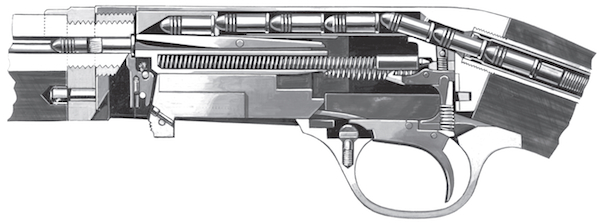
The Model 241 was advertised with a steel butt
plate. However, like the Model 121 slide-action rifle,
aluminum replaced the steel in the butt
plate in mid-1946.
|
Guns made early in the
production run had only MODEL 241
and the serial number stamped on the
left side of the receiver. The
Speedmaster and the Remington logo
were added in 1936. At least one slip-up
when the “Master” designation was
first added is obvious by the
“Gamemaster – Model 141” stamp
found on a Model 241 made in June,
1936.
The flat-sided receiver of the
Model 241 had a larger surface than
the Model 121, so it was the favorite
.22 rifle to Remington factory engravers.
Serial number 36109 was elaborately
engraved by Carl Ennis and
presented to C. J. Hoysradt, Regional
Promotion Representative for
Remington in Akron, Ohio. Another
Model 241 was engraved by three
different Remington engravers.
|
|
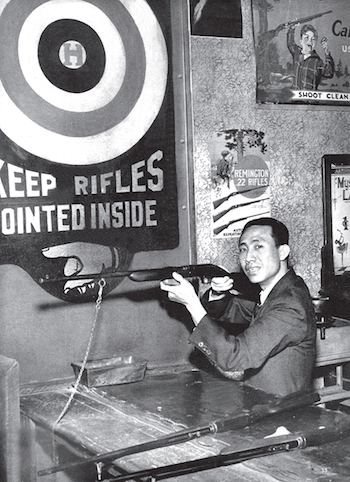
|
This picture appeared
on the cover of Life
Magazine (October
29, 1940) and pictured
the first man (Yuen
Chong Chan) who was
drafted into the U.S.
Army at the start of
World War II. Here
Mr. Chan practices his
aim at a local shooting
gallery that
features Remington
Model 241 Gallery
Rifles.
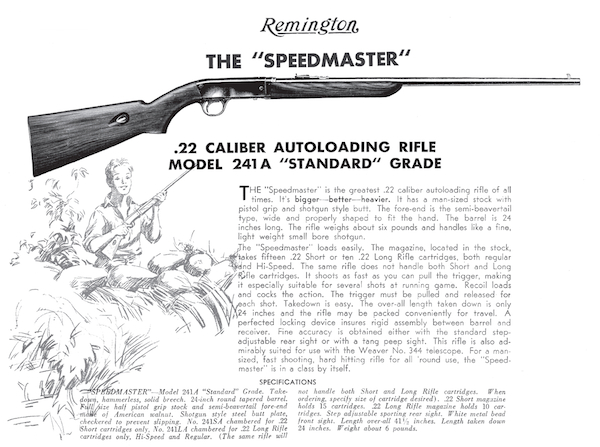
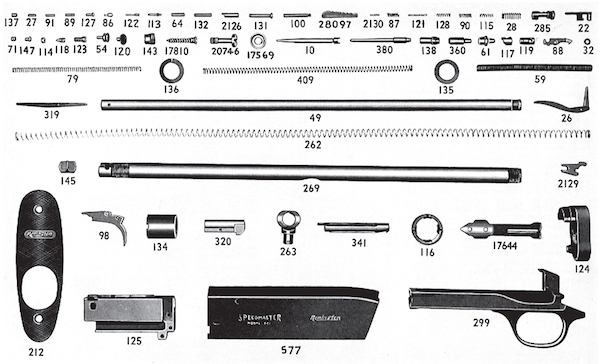
|
Barbera Sporting Goods altered some Model 241s for use at
Fort Sam Houston in San Antonio in 1939. The fore end was extended
almost to the end of the barrel, a high square front blade sight and a
Redfield receiver sight were installed, and a sling strap was added. If
encountered, these guns should be easily identified, but they are not
true “factory produced military trainers”.
From mid-1937 through mid-1939, Remington designers
experimented with Routeledge bored barrels and Remington Hi-Speed
shot cartridges. Despite successful trials, Remington’s Manager of Sales
decided on July 11th not to pursue a possible production of these guns.
Remington Model 241 autoloading rifles were popular in
shooting galleries in the late 1930s and ’40s. Remington supplied these
rifles in standard finish (blued barrel and receiver) and in “nickel trim
finish” (which included chrome plated receiver and trigger plate) or “full
nickel finishâ”(which included chrome plated receiver, trigger plate,
barrel and all other exposed metal parts). The Model 241 Gallery Gun
was also supplied (if the customer wanted) with a “course” (wide Unotch)
rear sight and a screw eye for a counter fastener. Shooting gallery
proprietors soon requested shell deflectors like those that were available
as an option on the Model 24. Some deflectors were built in the
Remington Tool Room in 1939 for certain galleries and for “export
orders”. Several configurations and various metals were tried, but
deflectors were never produced in any significant quantity.
|
|
Between 1942 and 1945, Remington supplied a total
of 7,658 Model 241 autoloading rifles for the U.S. Government.
An unknown number were sold to the U.S. Navy for
training in 1944 and “45.
In mid-1944, with the war still raging in Europe and
in the Pacific, Remington gun designer Charles H. Barnes
invented an improved Model 241 rifle with a sheet metal
receiver – to replace the more expensive machined solid steel
receiver on production guns. Evidently, this improvement
was not adopted, and full production of standard rifles
continued after World War II ended.
In January 1951, due to a Korean War shortage of
brass, authorization was given to make some Model 241
inner magazine tubes of steel, instead of brass. Approximately
500 steel tubes were made in 1951 for Model 121 and
Model 241 rifles.
The Remington Model 241 autoloading .22 was
replaced by the Remington Model 550, which had been
introduced back in August 1939. The end of the Model 241
was confirmed by an authorization to scrap surviving tooling
on January 28, 1955.
|
|
MODEL 241 “SPEEDMASTER” AUTOLOADING .22 CALIBER RIFLE
|
|
aka.
action:
barrel:
barrel marking:
butt plate:
cartridges:
designer/inventor:
finish:
front sight:
|
Model 241 SA or Model 241 LA
Blowback (recoil-operated) semiautomatic.
Hammerless. Bottom
ejection. Take-down. Receiver
milled from a solid block of steel.
Round, 24 inches in length
REMINGTON ARMS CO., Inc., Ilion, N.Y.,
MADE IN U.S.A., BROWNING’S
PATS. 1,372,336 — 1,381,448 — 1,740,187 —
1,889,099
Checkered steel (later aluminum),
shotgun-style
Available in .22 Short Only or
.22 Long Rifle Only, not
interchangeable
Basic design by John M.
Browning. Design improvements
by Crawford C. Loomis
U.S. Patents: #1,372,336,
#1,381,448, #1,740,187, and
#1,889,099
Blued barrel and receiver
Blade with white metal bead
|
introduced:
discontinued:
total production:
magazine:
options:
|
August 1935
1951
107,345 rifles
According to Remington factory
records, however larger quantities are possible
Tubular, loads from right side of butt
stock. Brass tube pulled out from butt
plate and rimfire cartridges dropped into
well. Spring pushes forward when tube is
replaced. Magazine holds 10 Long Rifle or
15 Shorts, but are not interchangeable.
Nickel plated trimmings. Remington
considered nickel as a trade term, as the
actual plating material was chrome.
Nickel trimmings included plating the
receiver and trigger plate. “Full Nickel”
included plating all external metal parts.
Factory “nickeled” Model 241s are only
rarely encountered.
Oil-finished stocks and forend wood.
Leather straps
|
|







